This was surprisingly good. The mild heat from Jalapeno was very nice. The meat was well seasoned and not dry and also much easier to remove from the bones compared to grilled sanma. For frozen sanma, this method of preparation appears better than grilling.
Wednesday, October 13, 2010
Stewed Pacific saury with Umeboshi さんまの梅煮
I posted sanma previously but I had two more frozen sanma left. I pondered what to make. Since it was a bit dry when grilled, I decided to make stewed sanma.

Here are two remaining sanma thawed (below). The innards are traditionally kept for this dish. Since this was previously frozen, I removed the innards. I cut the fish in three equal size potions.
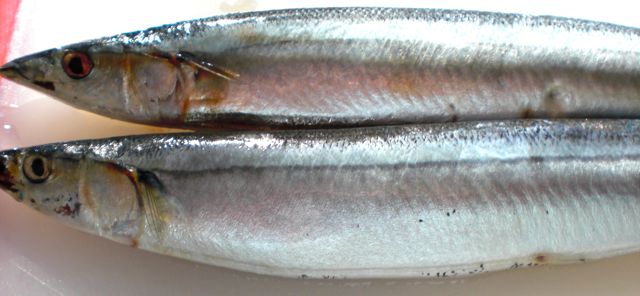
I washed and soaked the fish in salted cold water for 5 minutes to firm up the meat of the fish and then removed the excess moisture using paper towels (below left). For simmerig liquid, I first soaked two 2-inch long dried kelp pieces in 1 cup of cold water for a few hours. I placed the hydrated kelp pieces in the bottom of the sauce pan (to prevent the fish from sticking to the bottom of the pan). To the remaining broth (the kelp absorbed water, about 2/3 cup remained), I added mirin (2 tbs), sake (2 tbs), soy sauce (2 tbs), and rice vinegar (2 tsp). I also added the shredded meat of umeboshi (two) as well as their stones. Since I had ripe (red) Jalapeno peppers from our herb garden, I halved and seeded them but left the veins on and added them to the simmering liquid for some heat (or use dried red pepper). When it came to a simmer, I placed the fish into the pan. I put on a lid and simmered for 20 minutes and then let it cool in the liquid. Actually, we did not eat this the same day I made it. I put the pan in the refrigerator after it cooled to room temperature. I warmed it up the next day and served at room temperature.

I served it with a very thin julienne of fresh ginger (soaked in water for 10-15 minutes to remove the harshness) called "hari shouga" 針ショウガ and thin strips of scallion cut lengthwise and soaked in water. This preparation of scallion or "negi" is called "shiraga negi"白髪ねぎ or "white hair scallion". Since I did not have a thick Japanese scallion called "Tokyo scallion" in the U.S., it was difficult to make this from a small American green onion.
Tuesday, October 12, 2010
Three dishes with Miso mustard vinegar dressing からし酢みそ和え、三種類
I am not sure this is even worth posting. Here are three variations on the theme of "sumiso ae" 酢みそ和え.
1. Squid legs and crab salad イカのゲソとかにのからし酢みそ和え
2. Crab meat, semi-dried scallop, and sakuraebi カニ、貝柱、桜えびの酢味噌和え
3. Baby octopus, snake-belly-cut cucumber and tomato 子鮹と蛇腹切りのキュウリの酢みそ和え
Monday, October 11, 2010
Barbecued Cornish Game Hen 若鶏のバベキュー
This is certainly not Izakaya food but this small young chicken must be rather unique to the U.S. and I decided to post this dish. Exactly what is Cornish game hen is not really clear; whether this is a just young regular chicken or descendants of the original cross breed of Cornish game cocks and Rock hens (from which the name derived) in 1950 or similar cross breed developed later (1965) by Tyson food. But since the vast majority of "Cornish game hens" are supplied by Tyson, whatever cross breed that Tyson may have developed must be what we are eating here. Because of its small size, it is perfect to serve one whole bird per person. In the past I've served these birds instead of a big turkey for such occasions as Thanksgiving. For us, half of the bird is usually enough. We like this small bird since the meat is more tender and juicier than regular chicken, albeit it may not have a strong taste. I have never seen this bird in Japan but, apparently, Tyson brand can be had by mail order in Japan.
This could have been what we served if Jon had visited us along with no-crapple scrapple. The way I barbecue Cornish game hens is near identical to the recipe for regular chicken. I first squeeze the juice from two wedges of lemon inside and out the chicken and generously salt and pepper inside the cavity. I put the lemon wedges (the ones I used for the juice), coarsely chopped onion, crushed and skinned garlic cloves (as many as you like), and finely chopped fresh rosemary in the cavity. (Things have to be cut relatively small to stuff the small cavity of the bird). I truss it. I smear olive oil on the outside of the chicken and again generously coat the skin with salt and black pepper. I hot smoke/barbecue in a Weber kettle using indirect heat. This time I used hickory chips for smoking. I cook until the deepest part of the thigh registers 165-170F. I let it rest for at least 10 minutes.
My wife made mashed potatoes which were quite excellent. We used small (or baby) Yukon gold potatoes. After removing the "eyes" (leaving the skin on), she just wrapped several potatoes together in aluminum foil and put them along side the chickens in the Weber. The chicken took almost 45-50 minutes to cook and during that time, the potatoes were perfectly done. She mashed the potatoes and added salt, pepper, and very, very finely chopped red onion (this adds a nice burst of onion flavor to the bite), and creme fraiche instead of butter.
I also briefly grilled blanched and oil coated asparagus.
We think this is the best way to cook (hot smoke barbecue) and enjoy a chicken. Cornish game hens are particularly elegant (we think) when the whole bird is served per person. Although I have tried stuffing the cavity with porcini mushroom and grapes, or stuffing the space under the breast skin with herbs/goat cheese mixtures etc, we settled on the current simple method. Of course, you need to use your fingers to eat the bird, at that point, "elegance" is out-the-window.
Saturday, October 9, 2010
Grilled "Sanma" Pacific Saury さんまの塩焼き
"Sanma" 秋刀魚 (The kanji letters mean "autumn秋-blade刀-fish魚" indicating the season and the shape of the fish but you can not possibly pronounce these kanji as "sanma"). It is a fish seasonal for autumn in Japan. Historically this fish was considered lowly fare and an inexpensive source of protein for households that couldn't afford anything else. Regardless of its original lowly status, it has a dedicated following because of its rich oiliness and flavor (despite its ubiquitous bones). I was told it is getting expensive especially this year. You will never see it served in expensive restaurants but it is being served in cheap Japanese eateries, Izakaya, and at home.
The historic lowly status of this fish and the hard life of the people who could afford to eat only fish like sanma, is further exemplified in a famous Japanese poem by Haruo Satoh 佐藤春夫 publish around 1922 called "Song of Sanma" or 秋刀魚の歌 (link is in Japanese). One passage of the poem "Sanma nigai ka shoppai ka" 秋刀魚苦いか塩っぱいか "Does sanma taste bitter or salty?" has become a Japanese metaphor for the hardships of "life". As lowly as this fish may have been (not much meat, oily with lots of small bones), it is best eaten simply grilled with soy sauce and grated daikon. This point was well made in one of the classic stories entitled "Meguro-no sanma" 目黒のさんま (sorry, again, this link is in Japanese) from "Rakugo" 落語 the traditional Japanese art of story telling. For those who may not read Japanese here is the story in a nutshell. A lord out on a hunting trip stops at a farmer's house and asks for something to eat. The poor farmer only had the lowly Sanma and although it was something they knew a lord would never eat otherwise they simply grilled it and served it. The lord thought it was great. When he returned home, he wanted to taste it again. His servants went to the best fish market in Nihonbashi 日本橋 (No Tsukiji 築地 market at the time of this story) to get the sanma, carefully steamed it, removed all the little bones and served it in a lacquer ware bowel. After all that preparation the oil and flavor were gone. The lord told his servants this was not the fish he had before. When he found out it came from the best fish market, he declared as a self appointed sanma connoisseur, the best sanma had to come from "Meguro" the inland area where he had eaten it before. (even though Meguro could not possibly have had the best fish).
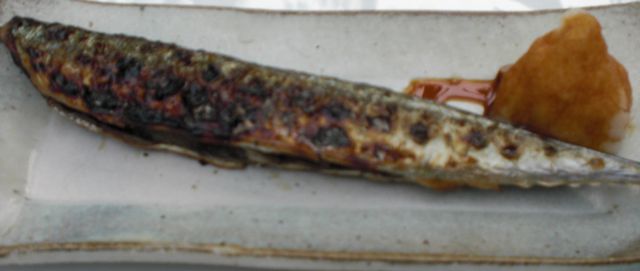 My wife who refers to this as "torpedo fish" has likened the experience of eating sanma, with all its tiny bones, to the time her tooth brush disintegrated while she was brushing her teeth and all the bristles headed down her throat. So as not to repeat that unique sensation while eating sanma she is very meticulous in how she debones the fish. She did not like the way I was "going at" this sanma so she took over the exercise and deboned the fish very neatly for me. Still you need to be careful of small bones.
My wife who refers to this as "torpedo fish" has likened the experience of eating sanma, with all its tiny bones, to the time her tooth brush disintegrated while she was brushing her teeth and all the bristles headed down her throat. So as not to repeat that unique sensation while eating sanma she is very meticulous in how she debones the fish. She did not like the way I was "going at" this sanma so she took over the exercise and deboned the fish very neatly for me. Still you need to be careful of small bones.
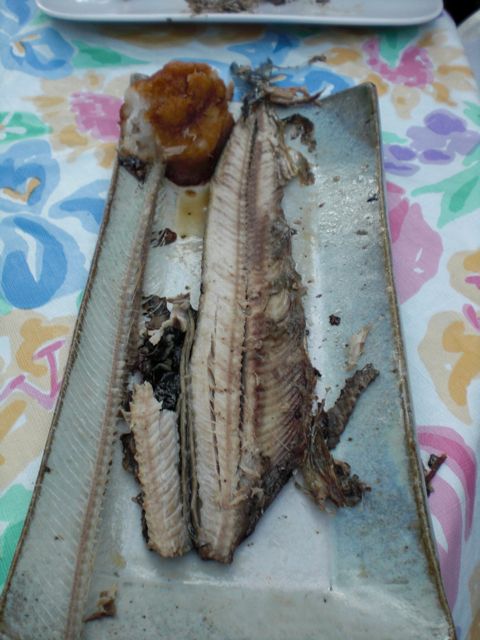
This tasted Ok but not as good as I remembered it in Japan. Although I removed the innards, the belly portion of was slightly bitter.
The historic lowly status of this fish and the hard life of the people who could afford to eat only fish like sanma, is further exemplified in a famous Japanese poem by Haruo Satoh 佐藤春夫 publish around 1922 called "Song of Sanma" or 秋刀魚の歌 (link is in Japanese). One passage of the poem "Sanma nigai ka shoppai ka" 秋刀魚苦いか塩っぱいか "Does sanma taste bitter or salty?" has become a Japanese metaphor for the hardships of "life". As lowly as this fish may have been (not much meat, oily with lots of small bones), it is best eaten simply grilled with soy sauce and grated daikon. This point was well made in one of the classic stories entitled "Meguro-no sanma" 目黒のさんま (sorry, again, this link is in Japanese) from "Rakugo" 落語 the traditional Japanese art of story telling. For those who may not read Japanese here is the story in a nutshell. A lord out on a hunting trip stops at a farmer's house and asks for something to eat. The poor farmer only had the lowly Sanma and although it was something they knew a lord would never eat otherwise they simply grilled it and served it. The lord thought it was great. When he returned home, he wanted to taste it again. His servants went to the best fish market in Nihonbashi 日本橋 (No Tsukiji 築地 market at the time of this story) to get the sanma, carefully steamed it, removed all the little bones and served it in a lacquer ware bowel. After all that preparation the oil and flavor were gone. The lord told his servants this was not the fish he had before. When he found out it came from the best fish market, he declared as a self appointed sanma connoisseur, the best sanma had to come from "Meguro" the inland area where he had eaten it before. (even though Meguro could not possibly have had the best fish).
In any case, we (regular consumers) can only get frozen sanma here. We had frozen sanma before and I was not impressed since it was dry and not oily enough (fresh seasonal sanma should be very oily; in Japanese parlance "abura ga notte iru" 油がのっている.) I read of Jon eating sanma at one of his Izakaya, which prompted me to try it at home again. For grilling, I do not particularly like to retain the innards (keeping the innards is the more traditional method, in that case, sanma really tastes bitter. I only consider keeping the innards if I stew the fish Japanese style and the fish is fresh). I thawed the sanma and cleaned it (removing head, gills and innards) and lightly salted it. I just grilled it over the charcoal fire.
P.S. We stopped by Tako Grill the other evening and Chef Kudo told us that they had fresh sanma. He offered sanma sashimi (I do not think I ever had sanma as sashimi). It tasted like "saba" サバ or mackerel but a bit more gentle tasting, quite oily but absolutely no fishy smell. It was surprisingly good. The head and bones were later served to us simply deep fried (This is called "hone senbei" 骨煎餅 "bone cracker", because of its crunchy crispy texture resembling Japanese crackers or "senbei"). We ate them all except for the very tip of the tail. Since the sashimi was excellent, we had to have grilled sanma. They kept the head but innards were cleaned (which is to our liking). This was by far the best sanma we have eaten. My wife said that after all these years she finally understands what sanma is all about. Only problem is that this is not a lowly cheap fish any longer. It is almost as expensive as Toro.
Thursday, October 7, 2010
Monkfish karaage アンコウの唐揚げ
We used to get monkfish or anglerfish 鮟鱇 tail meat fillet at our nearby fish market but, for some reason, we have not seen it for some time. Since we now occasionally go to a different grocery store to get pasteurized shell eggs, we checked their fish department and found monkfish.

Monkfish is an interesting deep water fish and Japanese eat almost every part of this ugly fish. I posted several Ankimo 鮟肝 or monkfish liver dishes--the liver is the best part of the monkfish. One of the most popular Japanese ways to cook monkfish is as a nabe 鍋 dish called "Ankou nabe" アンコウ鍋 in which the meat, liver, skin and even cartilage are cooked in miso flavored broth with vegetables. This fish has a very firm texture somewhat resembling lobster tail but does not have a strong taste. I used to bake this fish fillet imitating lobster tail by using paprika to give it a red "lobster" color. This time I decided to make a portion of it as "karaage" 唐揚げ. It is very similar to chicken "Tatsuta-age" 竜田揚げ in terms of how this is made.
The fillet has a slimy membrane covering the surface. Although once cooked, it is not too bothersome, it is best to remove most of the membrane. I used my fingers to pinch, pull up, and raise the membrane from the surface and slice it horizontally using a fillet knife. This way you could remove most of it without slicing off too much meat but you can decide if this is worth the effort. I cut the fish meat into bite sized chunks and marinate them for several hours in the refrigerator in a mixture of soy sauce, sake and mirin (2:1:1) with grated ginger. Just before cooking, I drain and pat dry with a paper towel and dredge the pieces in potato starch or "Katakuriko" 片栗粉 shaking off any excess flour. Meanwhile I heat up the peanut oil to about 170C (350F). I deep fry the fish until the surface is set and the meat is done (2-3 minutes depending on the size of the chunks).
Although I served this with green tea salt, it has enough seasoning so just lemon juice was fine. It has a nice crunch on the surface with firm texture and very nice flavor. We restrained ourselves and only enjoyed a small amount.
Tuesday, October 5, 2010
Matsutake rice 松茸ご飯
This is the last installment of Matsutake dishes. Because Japanese consider rice to be the main stay of the meal or "shushoku" 主食, "Takikomi goahnn" 炊き込みご飯 or rice seasoned with other ingredients is something special, especially if seasonal items are incorporated such as mushrooms (especially matsutake 松茸) and chestnuts 栗 in fall and bamboo shoots in spring. As I mentioned earlier, we got 1 Lb of of North American (Oregon) matsutake mushrooms. One of the dishes I made was a type of seasoned rice, "Matustake rice" 松茸ご飯. I made this with only matsutake so as not to cover up the subtle but distinctive aroma and flavor of the mushroom.
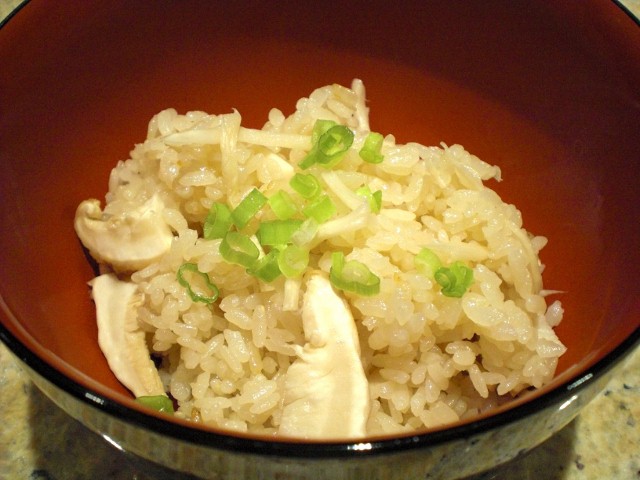 Matsutake: Among the matsutake we got, I picked a very large one for this dish (left upper in the image below). After clearing the matsutake as I described before, I separated the stem and the head since this was a large one. I torn the stem in the direction of the fibers (right upper in the image below). I made rather fine shreds of the stem and then halved the head and sliced it (left lower). I doused the pieces with sake and light-colored soy sauce or usukuchi shouyu 薄口醤油 and let it be absorbed for few minutes.
Matsutake: Among the matsutake we got, I picked a very large one for this dish (left upper in the image below). After clearing the matsutake as I described before, I separated the stem and the head since this was a large one. I torn the stem in the direction of the fibers (right upper in the image below). I made rather fine shreds of the stem and then halved the head and sliced it (left lower). I doused the pieces with sake and light-colored soy sauce or usukuchi shouyu 薄口醤油 and let it be absorbed for few minutes.
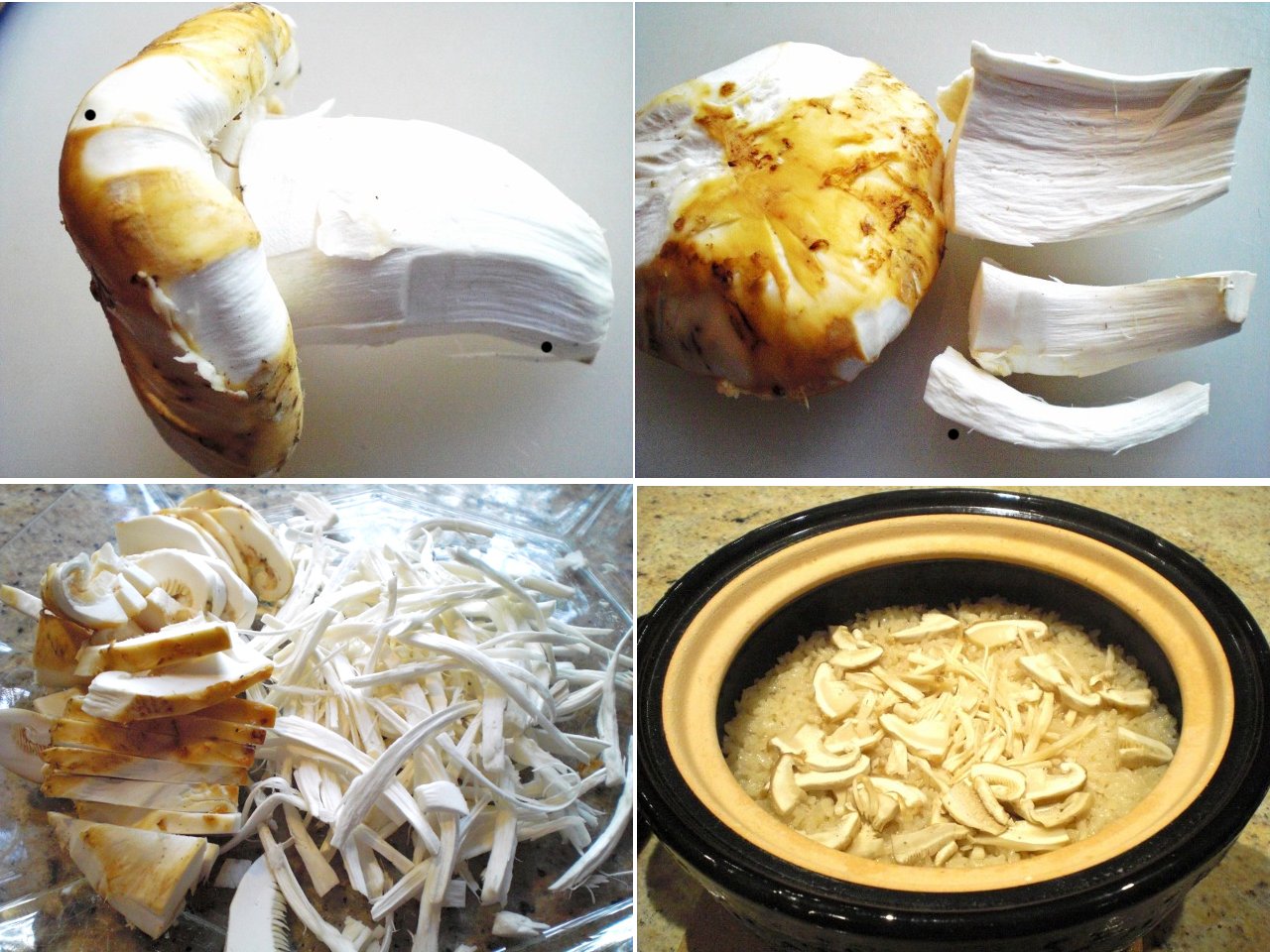
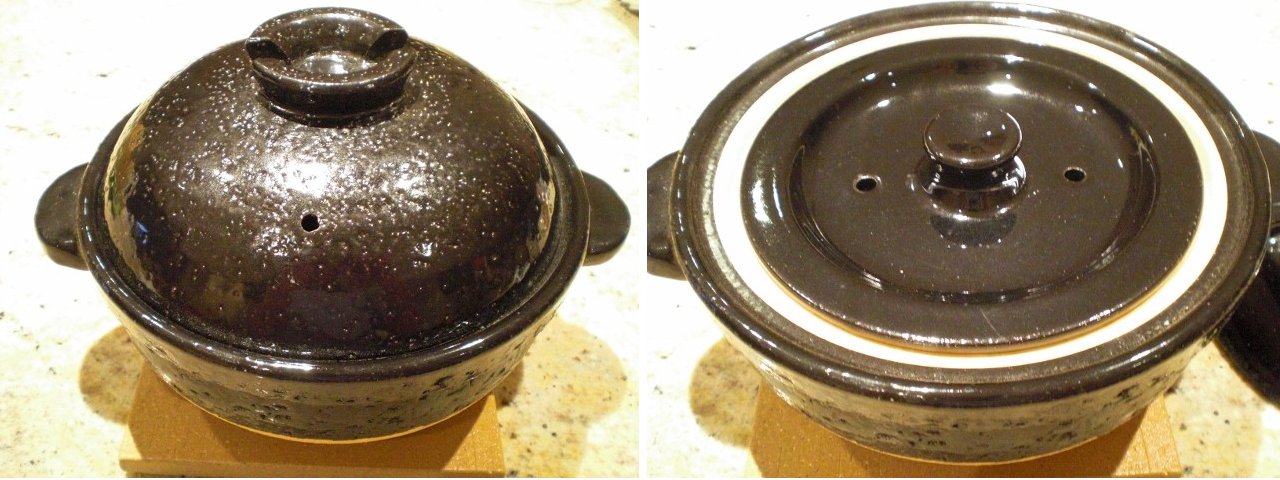 I do not use the donabe cooker that often just because it is a bit of work to clean and dry (especially drying) it after use. But there is no doubt it produces better cooked rice. The matsutake rice turned out really well with lots of flavor and a nice slightly firm texture-- it was perfect. Usually a special Japanese herb called "mitsuba" 三つ葉 is called for but I did not have any. I used the thinly sliced green part of a scallion instead for garnish. We were not able to finish all the rice, so we put the leftovers into small packages and froze them. We'll let you know how that works out. You should taste this at least once a year.
I do not use the donabe cooker that often just because it is a bit of work to clean and dry (especially drying) it after use. But there is no doubt it produces better cooked rice. The matsutake rice turned out really well with lots of flavor and a nice slightly firm texture-- it was perfect. Usually a special Japanese herb called "mitsuba" 三つ葉 is called for but I did not have any. I used the thinly sliced green part of a scallion instead for garnish. We were not able to finish all the rice, so we put the leftovers into small packages and froze them. We'll let you know how that works out. You should taste this at least once a year.
Cooking liquid: I could have used just water but it is better to use a very mild dashi broth and sake to enhance but not cover up the flavor of the matsutake. I soaked 5-7 inches of dried kelp 昆布 in about 500ml of cold water (I used filtered water) and let it stand overnight or, at least, several hours. The kelp will absorb water and assume its original state. It imparts a subtle kelp flavor to the broth. For 360 ml of rice, I used 400ml of the cooking liquid consisting of the kelp broth, 2 tbs of light colored soy sauce and 2 tbs of sake.
Rice: Many people like to add a small amount of glutenous rice (mochigome もち米) but I only used regular short grain Japanese rice from California (a brand called "Kagayaki"). I washed 2 cups (Japanese cups) or 360ml of rice. I washed the rice until the water came out clean not turbid. In the last few washes, I again used filtered water and drained the rice in a fine mesh strainer. I let it sit for 20-30 minutes. This appears to let the rice grains absorb just the right amount of water before cooking.
Cooking rice using an earthenware rice cooker: I could certainly have used my electric rice cooker but this time I used "Donabe" 土鍋 or earthenware rice cooker called "Kamado san". You can see the final product (right lower in the above image). When I removed the outer lid (see image below), I could really smell the matsutake. This type of rice cooker has an inner lid and an outer lid which make the pot act somewhat like a pressure cooker. As per the instructions that came with the cooker, I added the washed and drained rice (the original 2 Japanese cups or 360ml) and the cooking liquid (400ml). I placed the pot on a medium flame for 14 minutes and then turned off the heat and let it stand for 20 minutes.
Sunday, October 3, 2010
Auntie N's no-crapple scrapple with Pennsylvania Dutch sweet coleslaw スクラップルとペンシルバニアダッチコールスロウ
We were expecting a visiting dignitary to come to "Chez Norio" recently, Jon of EOITWJ, but things did not work out and we will have to wait for another chance. In any case, said dignitary is quoted as saying "Now Scrapple, it's cool because you know it's full of crap, or rather is made of nothing but crap, and that's expected". In response to this statement, I let him know of the existence of Auntie N's no-crapple scrapple. So, we thought it would be most appropriate that our visitor should try her scrapple. Since it is a two-day process to make no-crapple scrapple and weekends are the only time she can do it, I asked my wife to make her specialty before we learned that our visitor could not make it. Actually, she made the best scrapple ever.
We had this as a part of an eclectic series of small dishes for the evening (mostly leftover from the weekend). The other small dishes included Yakitori-style drummetts and wings, and stewed daikon, pork spare rib (left over from the scrapple making) with the addition of tofu and broccoli. Since I had only a small amount of tofu left after the daikon, pork spare rib, tofu and broccoli dish, I made it as tofu dengaku (in a toaster oven) to use it all up. I served it with the scrapple and Pennsylvania Dutch sweet coleslaw (it may look too eclectic but, at least, it has about the same dimensions as the scrapple) as shown below.
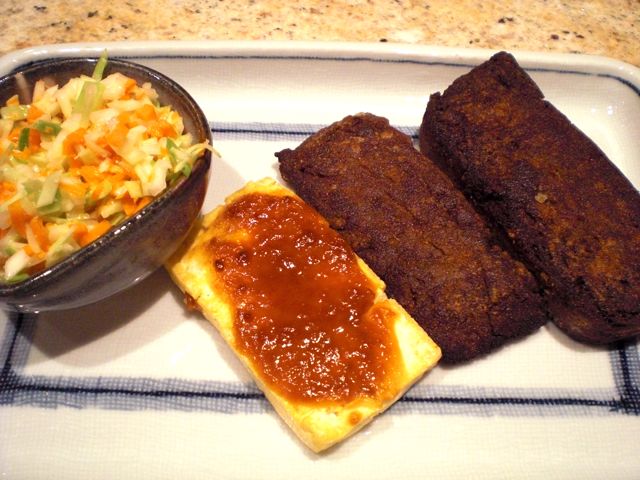 This was the best scrapple ever! Nice mix of spices and porky flavor. Jon, you missed a good one. But don't worry there is more where that came from.
This was the best scrapple ever! Nice mix of spices and porky flavor. Jon, you missed a good one. But don't worry there is more where that came from.
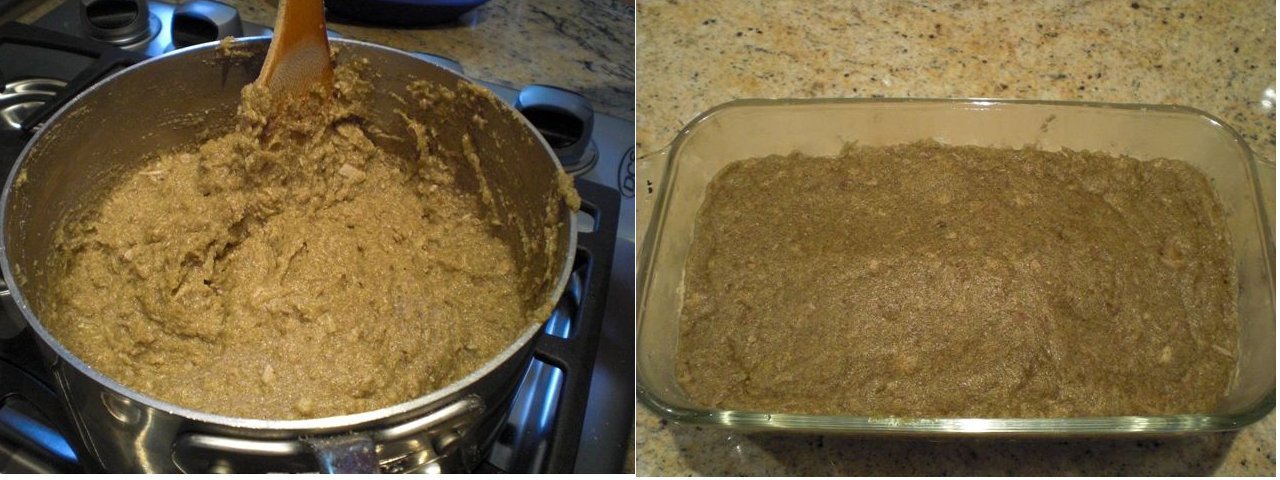 Look at this lovely mud/sewer water color. The addition of buckwheat flour really added flavors and made the color authentic but since this is no-crapple scrapple, no mystery meat or crap is in this one.
Look at this lovely mud/sewer water color. The addition of buckwheat flour really added flavors and made the color authentic but since this is no-crapple scrapple, no mystery meat or crap is in this one.
We had this as a part of an eclectic series of small dishes for the evening (mostly leftover from the weekend). The other small dishes included Yakitori-style drummetts and wings, and stewed daikon, pork spare rib (left over from the scrapple making) with the addition of tofu and broccoli. Since I had only a small amount of tofu left after the daikon, pork spare rib, tofu and broccoli dish, I made it as tofu dengaku (in a toaster oven) to use it all up. I served it with the scrapple and Pennsylvania Dutch sweet coleslaw (it may look too eclectic but, at least, it has about the same dimensions as the scrapple) as shown below.
Subscribe to:
Comments (Atom)

